
Canidae is a biological family of dog-like carnivorans, colloquially referred to as dogs, and constitutes a clade. A member of this family is also called a canid. The family includes three subfamilies: the Caninae, and the extinct Borophaginae and Hesperocyoninae. The Caninae are known as canines, and include domestic dogs, wolves, coyotes, foxes, jackals and other species.

Borophagus is an extinct genus of the subfamily Borophaginae, a group of canids endemic to North America from the Middle Miocene epoch through the Early Pleistocene epoch 12—1.8 Mya.

Aelurodon is an extinct canid genus of the subfamily Borophaginae which lived from the Barstovian land mammal age of the middle Miocene to the late Miocene epoch. Aelurodon existed for approximately 10.7 million years.
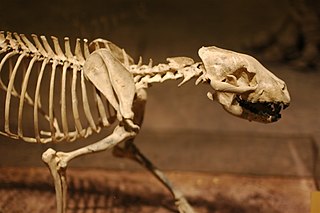
The extinct Borophaginae form one of three subfamilies found within the canid family. The other two canid subfamilies are the extinct Hesperocyoninae and extant Caninae. Borophaginae, called "bone-crushing dogs", were endemic to North America during the Oligocene to Pliocene and lived roughly 34—2.5 million years ago, existing for about 33.5 million years.

Epicyon is a large, extinct, canid genus of the subfamily Borophaginae, native to North America. Epicyon existed for about 15 million years from the Hemingfordian age of the Early Miocene, to the Hemphillian of the Late Miocene. Epicyon haydeni is the largest known canid of all time, with the type species reaching 2.4 m (7.9 ft) in length, 90 cm (35 in) in shoulder height and approximately 100–125 kg (220–276 lb) in body mass. The largest known humerus specimen belonged to an individual weighing up to 170 kg (370 lb).

Hesperocyon is an extinct genus of canids that was endemic to North America, ranging from southern Canada to Colorado. It appeared during the Uintan age, –Bridgerian age (NALMA) of the Mid-Eocene– 42.5 Ma to 31.0 Ma. (AEO). Hesperocyon existed for approximately 11.5 million years.

Cynodesmus is an extinct genus of omnivorous canine which inhabited North America during the Oligocene living from 33.3—-26.3 Ma and existed for approximately 7 million years.

The genus Leptocyon includes 11 species and was the first canine. They were small and weighed around 2 kilograms (4.4 lb). They first appeared in North America around 34 million years ago in the Oligocene, at the same time as the Borophaginae, with whom they share features, indicating that these were two sister groups. Borophaginae skull and dentition were designed for a powerful killing bite compared with the Leptocyon which were designed for snatching small, fast-moving prey. The species L. delicatus is the smallest canid to have existed. At the close of their genus 9 million years ago one Leptocyon lineage resembled the modern fox.

The extinct Hesperocyoninae are one of three subfamilies found within the canid family. The other two canid subfamilies are the extinct Borophaginae and extant Caninae.
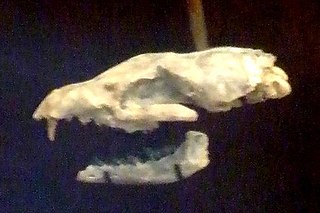
Archaeocyon is an extinct genus of the Borophaginae subfamily of canids native to North America. It lived during the Oligocene epoch 32-24 Ma., existing for approximately 8 million years. Species of Archaeocyon are among the earliest known borophagines, although a species of Otarocyon has a slightly earlier first appearance. Fossils have been found across the northern Great Plains and along the west coast of North America.

Tomarctus is a canid genus of the extinct subfamily Borophaginae which inhabited most of North America during the late Early Miocene to the Early Barstovian age of the Middle Miocene. Tomarctus existed for approximately 6.83 million years.

Cynarctus is an extinct genus of the Borophaginae subfamily of canids native to North America. The genus was first founded by W. D. Matthew in 1901, based from a pair of lower jaws, Cynarctus saxitilis, found in the Pawnee Creek Beds of Colorado. It lived during the Middle to Late Miocene 16.0—10.3 mya, existing for approximately 5.7 million years. Fossils have been uncovered in Colorado, California, Maryland, western Nebraska, and Texas. It was likely an omnivore, and lacked the bone-cracking adaptations found in some later borophagines. Newer findings have proved the genus to be described as a large dog-like raccoon, a result from combining characteristics from Canidae with Procyonidae.
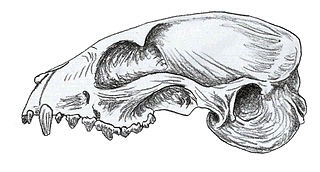
Otarocyon is an extinct genus of the Borophaginae subfamily of canids native to North America. It lived during the Oligocene epoch, about 33.3—20.6 Ma. Fossils have been found only in Montana, Wyoming, and South Dakota.
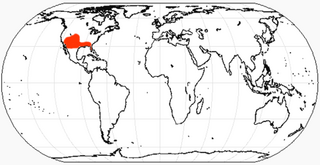
Carpocyon is an extinct genus of the Borophaginae subfamily of canids native to North America. It lived from the Middle to the Late Miocene, 13.6 to 5.3 Ma Mya, existing for approximately 16.5 million years. The four species in the genus varied in size, with the largest being about the size of a wolf; all had relatively small teeth, suggesting a diet that was more omnivorous than that of other contemporary borophagines.

Microtomarctus is an extinct monospecific genus of the Borophaginae subfamily of canids native to North America. It lived during the Early to Middle Miocene, and existed for approximately 7 million years. Fossil specimens have been found in Nebraska, coastal southeast Texas, California, New Mexico, Nevada and Colorado. It was an intermediate-size canid, and more predaceous than earlier borophagines.

Cynarctoides is an extinct genus of the Borophaginae subfamily of canids native to North America. It lived from the Early Oligocene to the Middle Miocene, 33.3—13.6 Mya, existing for approximately 19.7 million years. Seven species are currently recognised, all of which are estimated to have weighed no more than 1 kilogram (2.2 lb). They had an unusual dentition that implies an omnivorous, or possibly even herbivorous, diet.
Borophagus dudleyi is an extinct species of the genus Borophagus of the subfamily Borophaginae, a group of canids endemic to North America from the late Hemphillian of the Miocene epoch through the Pliocene epoch. Borophagus dudleyi existed for approximately 5.4 million years.
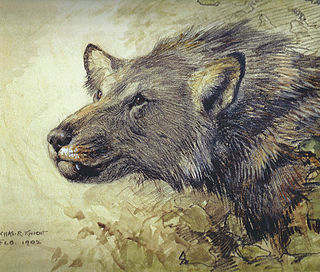
Borophagus hilli is an extinct species of the genus Borophagus of the subfamily Borophaginae, a group of canids endemic to North America from the Late Miocene until the Pliocene.

Borophagus diversidens is an extinct species of the genus Borophagus of the subfamily Borophaginae, a group of canids endemic to North America from the late Miocene epoch through the Pliocene epoch 4.9—1.8 Ma.

Borophagus secundus is an extinct species of the genus Borophagus of the subfamily Borophaginae, a group of canids endemic to North America from the Early Miocene epoch through the Late Miocene epoch. Borophagus secundus existed for approximately 17.7 million years.


















